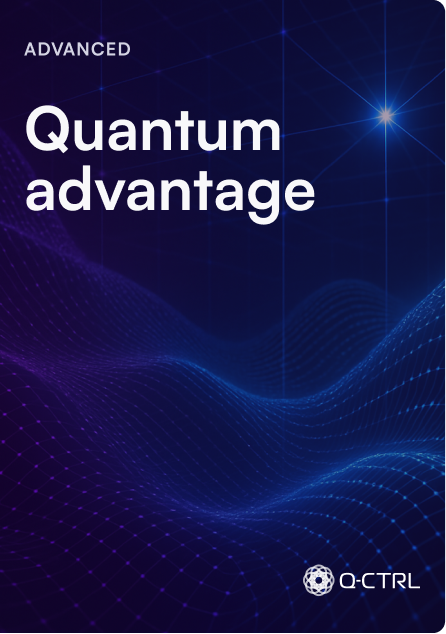In this article, we explore three key points that highlight how Q-CTRL is accelerating the timeline to quantum advantage through software:
- Quantum advantage is becoming real: Quantum systems are starting to solve useful problems better than classical ones, and Q-CTRL is a key driver in leading that shift.
- Optimization is a strong early use case: We’ve shown that quantum computing can outperform classical methods in real-world optimization tasks like logistics and scheduling.
- Error suppression delivers results today: Our performance-management infrastructure software boosts quantum hardware performance now, without waiting for fully error-corrected systems.
Quantum advantage is the holy grail in quantum technologies. It refers to the point where quantum systems outperform conventional technology in real-world applications. For example, in quantum sensing, Q-CTRL was the first to demonstrate commercial quantum advantage in navigation, where our quantum sensors outperformed a strategic-grade GPS backup system in environments where GPS was unavailable or unreliable.
In terms of quantum computing, which will be the focus of this article, quantum advantage marks the point where quantum systems begin solving practical problems better, faster, or more affordably than classical alternatives. In other words, doing something useful.
Unlike prior milestones such as “quantum supremacy,” which were achieved in narrow, commercially irrelevant problems, quantum advantage is expected to act as a catalyst for strategic focus and commercial investment across the sector.
When quantum advantage is definitively achieved for a commercially relevant problem, all of the broad exploration currently undertaken in architectures, hardware paradigms, device designs, and software layers will find a pathway for focused, concentrated effort.
Exploratory development will continue for the long term, but we will also see the sector try to replicate the machines used in the quantum advantage demonstrations for commercial deployment, and match other problems to the mathematical structure of the problem for which advantage was achieved.
For the industry, the arrival of quantum advantage will erase much of the perceived timing risk in the sector. Venture capitalists will pour funds into aligned businesses. Corporate tech scouting programs will suddenly begin investing beyond small-scale PoCs.
In effect, quantum advantage will become a blueprint for success, triggering the start of true sector-wide scaling. For quantum computing, it will represent the kind of tipping point that ChatGPT provided for AI.
When will quantum advantage arrive?
The Boston Consulting Group first predicted in 2019 that it’s less than a decade away. Despite lots of discussion and debate, this timeline has continued to narrow with progress in the sector. Recently, IBM predicted that quantum advantage for certain simulation problems may come as early as 2026, and Q-CTRL has identified a clear pathway to advantage in optimization around 2027/2028.
IBM’s blog, which highlights the view that the industry is entering the “Quantum Advantage Era” marks a pivotal moment for the field. It reflects growing recognition that real value from quantum computing is emerging now, not in the distant future, and that earlier timelines may have been too conservative.
Error remains the key bottleneck to be overcome.
Recent progress definitively addresses the core notion that full-blown quantum error correction (QEC) does not appear necessary to realize quantum advantage, shaving years or decades off of timelines to delivery. QEC is a long-term play delivering a huge expansion in the power of future quantum computers, but it is not a choke point in capturing value for enterprises.
For Q-CTRL, this isn’t a new direction. Being on the verge of realizing quantum advantage is the result of years of focused work building the AI-powered infrastructure software that makes quantum technology useful.
This year alone, we’ve made tangible contributions to the global progress toward quantum advantage, achieving new quantum computing performance records, partnering with industry to solve real-world computational problems, and setting milestones in quantum-system fidelity and scale, all through software.
The Boston Consulting Group says 90% of value capture will go to early adopters of quantum computing. Our efforts empower businesses to realize value today through software-led innovation, so they can be ideally positioned ahead of the achievement of practical quantum advantage and the rollout of large-scale systems.
Q-CTRL is the key to accelerating commercial impact by unlocking new industry applications and boosting the quality of results derived from today’s machines, turning early technical demonstrations into real business insight.
Getting across the threshold will require three key developments to come together:
- Identifying strong candidate problem classes amenable to quantum computing
- Working with partners to focus on narrow, high-value applications underserved by alternative technologies
- Building the core performance-enhancing technologies to deliver real gains on emerging hardware.
Optimization as a key candidate problem class
Optimization problems are some of the most promising near-term applications for quantum computing. From logistics and finance to biochemistry, these problems underpin real operational challenges that can benefit from quantum-enhanced solutions.
Most importantly, the mathematics of optimization makes it amenable to execution on quantum computers. The underlying algorithms are generally heuristics, meaning they don’t have definitive proofs of advantage from a theoretical perspective. However, heuristics rule the world from a practical perspective. Beating alternative (high-quality) classical heuristics then becomes the core challenge on which to focus.
Last year, we used IBM Quantum hardware to successfully solve optimization problems 4x larger than those previously demonstrated on quantum devices, with fully correct solutions, not approximations. This capability is now available to all IBM Premium customers through our Optimization Solver Qiskit function. By integrating our world-leading AI-driven error suppression with easy-to-use orchestration of classical and quantum resources, we achieved computational results that outperformed both leading dedicated classical solvers and, for the first time, quantum annealers.
Partnering with industry for real-world impact
In our partnership with Network Rail in the UK, we tackled a new class of problems, directly leveraging our Performance Management Qiskit Function to calculate train schedules and routes using real-world data, one of the most complex logistical problems in the transportation sector. Together, we modelled real network congestion and capacity constraints, running quantum optimization algorithms to improve the timetabling of routes through some of Britain’s busiest stations.
What sets this work apart is its scale and real-world relevance. In this collaborative demonstration, we successfully solved the largest constrained optimization problem ever run on quantum hardware. The results showed that quantum computing could be directly relevant to today’s operational challenges, not just future aspirations or made-up toy problems.
Similarly, last year, we also tackled a constrained supply-chain optimization challenge focused on minimizing transportation costs and carbon emissions across Airbus and BMW’s manufacturing network using IBM and IonQ hardware. Here, we focused on solving key components of real problems, not simplifications designed to make the problems easier for quantum computers, marking a significant step toward practical quantum-enhanced logistics solutions.
These recent collaborations with Network Rail, the Department for Transport UK, and Airbus/BMW demonstrate how quantum computing can support strategic logistics planning, increasing efficiency and reducing downstream delays, using today’s machines. And in these efforts, we extrapolated to identify the opportunity to achieve quantum advantage with machines being built over just the next few years.
Most importantly, we showed how working to apply our enabling software directly in collaboration with domain experts could reveal surprising opportunities to deliver quantum advantage without the need to access future fault-tolerant systems.
Optimization may or may not be “first” to achieve quantum advantage, but there is growing confidence that it will deliver early value thanks to direct engagement with end users.
Pushing the boundaries of hardware with new error-reduction technologies
Q-CTRL has a lengthy track record of developing new software technologies that push quantum hardware to the limits. These capabilities combine insights from quantum control, AI, and computer science to deliver efficient error reduction everywhere that errors occur. We have focused on the most effective and efficient strategies—error suppression and quantum error correction—in order to deliver real augmentation of today’s hardware and chart a path to large-scale machines in the long term.
Our focus is always on delivering greater value to users today, giving real net performance enhancements that are practically achievable in the real world. Recently, we’ve set new records in quantum hardware performance through innovations in new forms of error reduction that may prove vital in the path to quantum advantage.
Specifically, we realized the world’s largest verifiable, maximally entangled state at 75 qubits. Entanglement is a foundational resource in the operation of quantum computers. The ability to create large, high-fidelity entangled states is essential for unlocking more powerful quantum algorithms and advancing toward error-corrected fault-tolerant quantum systems.
In this case, we achieved two record-setting demonstrations combining our existing performance-management tools with low-overhead error detection to enhance both entangled-state preparation and quantum logic operations over large distances (gate teleportation).
Our lightweight error-detection protocol showed that we could actually make a quantum device more powerful using components of QEC without waiting for full fault-tolerant encoding. This is in contrast to nearly every other demonstration, where a machine’s utility decreases when using full QEC because it requires so many resources to operate. It’s a great demonstration of threading the needle between practical enhancement of real hardware and validation of techniques with theoretical relevance to future fault tolerance.
These achievements showcase how deep quantum-control expertise, broadly deployed through our software, could enable real system gains even on today’s noisy devices.
This kind of innovation, which delivers real net performance improvements on today’s machines, is critical to helping the community reach quantum advantage.
Accelerating the path toward practical quantum advantage
What unites these demonstrations is their impact right now: They move quantum from the domain of scientific exploration to useful deployment of a new computational tool for critical problems.
From dramatically scaling optimization problems to achieving record-breaking entanglement, our work is built on rigorous benchmarking, deep industry collaboration, and an unwavering focus on delivering tangible customer outcomes.
Achieving quantum advantage isn’t realized by hitting a single milestone. It’s a process of hypothesis, innovation, validation, and delivery. That’s exactly where our AI-powered infrastructure software excels, propelling quantum systems emerging over just the next few years to outperform classical alternatives in speed, scale, and accuracy.
Through our software, partnerships, and research, we'll continue to build the essential infrastructure that ensures quantum systems achieve dependable, high-performance results now and into the future.













